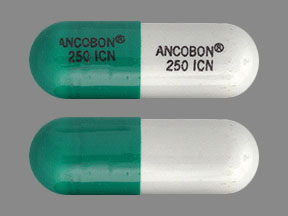
Flucytosine Coupons & Savings Card – Discount Prices from $88.82
Generic for: Ancobon
My prescription
Edit
250MG, Flucytosine (30 Capsules)
Select pharmacy

CVS
$88.82
COUPON PRICE
Walgreens
$310.50
COUPON PRICE
Albertsons
$625.02
COUPON PRICE
Walmart
$1964.67
COUPON PRICEFree Flucytosine Savings Card

CVS
$88.82
Show this coupon to your pharmacist
ID
LHET707829
PCN
GDC
BIN
015995
GRP
GDRX
This coupon is not insurance
More prescriptions for fungal infection
More prescriptions for fungal infection
Flucytosine dosage forms
Dosage Quantity Price from Per unit 250MG 30 Capsules $93.75 $3.13 250MG 60 Capsules $169.50 $2.83 250MG 90 Capsules $245.25 $2.73 500MG 30 Capsules $263.34 $8.78 500MG 60 Capsules $508.68 $8.48 500MG 90 Capsules $754.02 $8.38
| Dosage | Quantity | Price from | Per unit |
|---|---|---|---|
| 250MG | 30 Capsules | $93.75 | $3.13 |
| 250MG | 60 Capsules | $169.50 | $2.83 |
| 250MG | 90 Capsules | $245.25 | $2.73 |
| 500MG | 30 Capsules | $263.34 | $8.78 |
| 500MG | 60 Capsules | $508.68 | $8.48 |
| 500MG | 90 Capsules | $754.02 | $8.38 |
Flucytosine Warnings
It is important to be informed about the potential risks and necessary precautions when using this medication, especially if you belong to certain vulnerable groups. Below are critical safety and warning details that should be carefully considered:
Kidney Function: If you have kidney problems, this medication requires careful monitoring. Flucytosine is eliminated through the kidneys, and impaired kidney function can lead to an accumulation of the drug, increasing the risk of kidney damage. Regular blood tests will be required to monitor kidney function. Contact your healthcare provider if you experience changes in urine output, swelling in hands or feet, or difficulty breathing, as these may indicate kidney issues.
Liver Function: Though rare, flucytosine can cause severe liver damage or even liver failure. Blood tests are necessary to ensure proper liver function before and during treatment. Symptoms of liver damage include unexplained stomach pain, nausea, vomiting, dark urine, pale stools, or yellowing of the skin or eyes. Immediate medical attention is required if these occur.
Blood and Bone Marrow Health: This medication may harm bone marrow, leading to reduced blood cell production, which can be life-threatening, especially for those with weakened immune systems. Symptoms include fatigue, rapid heartbeat, pale skin, dizziness, and breathing difficulties. Blood tests are essential to monitor blood cell counts during treatment.
Allergic Reactions: Severe allergic reactions can occur. Seek immediate medical help if you experience hives, rash, swelling of the lips or tongue, or difficulty breathing after taking the medication.
Ensure to discuss any pre-existing conditions or other medications you are taking with your healthcare provider to mitigate risks associated with flucytosine. Regular monitoring and communication with your healthcare provider are vital for safely managing side effects and ensuring effective treatment.
Flucytosine Side Effects
Common side effects:
- nausea
- vomiting
- stomach pain
- diarrhea
- confusion
- headaches
- sensitivity to sunlight
- fatigue
- dizziness
- dry mouth
- loss of appetite
Less common but important to monitor:
- persistent nausea or vomiting
- abdominal pain
- dark urine
- yellowing of the eyes or skin
- unusual tiredness
- pale skin
- fast heartbeat
- signs of infection
- unexplained bleeding
- muscle weakness
- rash
- swelling
- difficulty breathing
Serious side effects:
- kidney failure
- liver failure
- bone marrow damage
- heart attacks
- GI bleeding
- severe allergic reactions
Flucytosine Interactions
Flucytosine (Ancobon) can interact with several other medications, so it’s important to inform your doctor and pharmacist about all the drugs and supplements you are taking, including over-the-counter medications, vitamins, and herbal products.
Some interactions to be aware of include:
- Cytarabine and other drugs that might affect kidney function, such as NSAIDs like Ibuprofen or Naproxen. These interactions can potentially harm kidney health.
- Medications that reduce bone marrow function or lower blood cell counts, including certain cancer chemotherapies and trimethoprim/sulfamethoxazole. These can weaken your immune system.
- Levomethadyl and Tegafur should not be used with Flucytosine, as the combination is not recommended.
- Zidovudine may be used with Flucytosine only in specific cases, and your doctor might adjust your dosages if both are needed.
Additionally, Flucytosine may interfere with certain lab tests, such as serum creatinine, potentially leading to inaccurate results. Ensure that all healthcare professionals involved in your care are aware that you are taking this medication.
